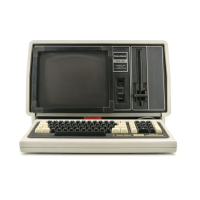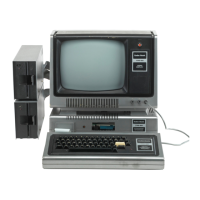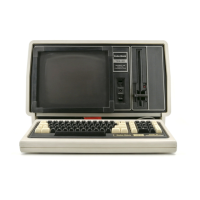MODE
CONTROL !NT*/EXT
-
used to select the
semigraphic
—
6
mode. This line is
connected to the same PIA
bit asGM0.
MODE CONTROL INV
-
selects between
a
black character
on
a green background
or a
green character on
a black
background.
This line is connected to data bit
6.
MODE
CONTROL GM0, GM1, & GM2
-
these
three lines
are
used to select
one
of
eight
full
graphic modes.
CLOCK
(CLK)
-
The VDG clock input (CLK) requires
a
3.579545 MHz
(standard) TV crystal frequency square
wave.
THREESTATE CONTROL
-
(MS*)
is
a TTL compatible
input which,
when low,
forces
the VDG address lines
into a
high
impedance
state.
The following
output signals are
used by the Color Computer.
LUMINANCE (Y)
-
this six
level analog output contains
composite
sync, blanking, and four levels of
video
luminance.
0A
-
This three
level
analog output is used in
combination
with
0B
and Y
outputs
to specify one of eight
colors.
0B
—
This four
level analog output is used in
combination
with
0A and Y outputs
to
specify
one
of eight
colors. Additionally,
one
analog
level is used
to specify
the time of
the
color burst
reference
signal.
CHROMA
BIAS
(CHB)
-
This pin is an
analog
output
and
provides
a DC
reference
corresponding
to
the
quiescent
value
of
0A and
0B.
CHB
is
used to guarantee
good thermal tracking
and
minimize
the
variation
between
the parts.
FIELD
SYNC
-
(FS*)
-
The high
to low transition
of
the
FS*
output
coincides with
the end of
active
display area.
The
low to
high transition
of FS* coincides with
the trailing
edge
of the
vertical
synchronization
pulse.
HORIZONTAL
SYNC
-
(HS*)
-
The
HS*
pulse is
synchronous
with
the
horizontal
synchronization
pulse
furnished
to the
television receiver
by the VDG.
The high
to
low
transition
of
the HS*
output
coincides
with
the leading
edge
of the
horizontal
synchronization
pulse.
Together,
the VDG
(U7) and
the MC6883
(U10)
are
capable
of
generating
a large number
of
distinct
display modes.
Of this
large
quantity,
fourteen
separate
Modes will
be described.
These
include an
alphanumeric,
five
semigraphic,
and eight full
graphic
modes.
ALPHANUMERIC
DISPLAY
MODES
-
All
alphanumeric
modes
occupy an
8 x 12 dot
character
matrix
box and
there
are
32 x 16 character
boxes per
TV frame.
Each
horizontal
dot
(dot-clock)
corresponds
to one
half the
period duration
of the
3.58 MHz
clock and
each vertical
dot
is
one
scan
line. One of
two
colors for
the lighted
dots may
be selected
by
the color
set
select pin (pin
39).
An
internal
ROM will
generate 64
ASCII
display
characters
in a standard
5x7 box.
Six bits
of
the
eight-bit
data
word are
used for the
ASCII
character
generator
and
the two
bits
not used are
used to
implement
inverse
video
and mode
switching
to
semigraphics
-4,
-8,
-12, or
-24.
The
ALPHA
SEMIGraphics
-4
mode translates
bits through
3
into
a
4 x
6
dot element
in the
standard
8x12 dot
box.
Three
data
bits may
be used
to select one
of eight
colors for
the entire
character
box.
The extra
bit is
used to
switch to
alphanumeric.
A 512 byte display
memory is required.
A
density of
64 x 32 elements is available
in the display area.
The element area is four
dot-clocks wide
by six
lines
high.
The
ALPHA
SEMIGraphics
-6
mode
maps six 4
x 4 dot
elements
into
the
standard
8 x 12
dot alphanumeric
box, a
screen
density of
64 x 48
elements
is available.
Six bits are
used
to generate
this map
and
two data bits
may be
used
to
select one of
four colors
in the display
box.
A
512
byte
display
memory is
required. The
element area is four
dot-
clocks
wide by four lines high.
The ALPHA SEMIGraphics
-
8 mode maps eight 4
x 3 dot
elements into the standard
8x12 dot box. This mode requires
four memory locations
per box and each memory location
may
specify one of eight colors or
black. A 2048 byte display
memory
is
required.
A density of 64
x
64 elements
is
available
in the display
area. The element area is four dot-clocks
wide
by three lines
high.
The ALPHA
SEMIGraphics -12
mode
maps twelve
4
x 2 dot
elements
into the
standard
8x12 dot box. This
mode requires
six
memory
locations per
box
and each memory
location may
specify
one
of
eight colors or
black.
A
3072 byte display
memory
is
required.
A density of
64 x 96 elements
is available
in the
display area. The element
area is four
dot-clocks wide
by two lines high.
The
ALPHA
SEMIGraphics
-24
mode
maps twenty-four 4
x 1
dot
elements
into
the standard
8 x 12 dot box.
This mode
requires
twelve
memory
locations
per box
and each memory
location
may specify one
of eight
colors
or black.
A
6144
byte
display
memory is
required.
A density
of 64 x 192
elements
is available
in the
display are.
The element
area is four
dot-
clocks
wide
by one line high.
22

